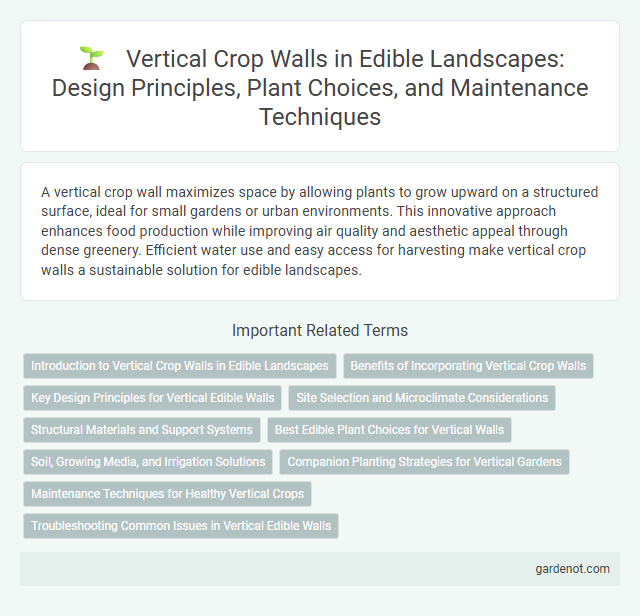A vertical crop wall maximizes space by allowing plants to grow upward on a structured surface, ideal for small gardens or urban environments. This innovative approach enhances food production while improving air quality and aesthetic appeal through dense greenery. Efficient water use and easy access for harvesting make vertical crop walls a sustainable solution for edible landscapes.
Introduction to Vertical Crop Walls in Edible Landscapes
Vertical crop walls transform limited urban spaces into productive edible landscapes by utilizing vertical surfaces for growing fruits, vegetables, and herbs. These innovations maximize yield per square foot by integrating hydroponic or soil-based systems, enhancing biodiversity and promoting sustainable food production. Incorporating vertical crop walls supports urban agriculture, reduces food miles, and contributes to greener, healthier cities.
Benefits of Incorporating Vertical Crop Walls
Vertical crop walls maximize urban space by enabling the cultivation of a diverse range of edible plants in compact areas, enhancing food production efficiency. These structures improve air quality and reduce heat islands through increased greenery while promoting biodiversity by providing habitats for pollinators. Incorporating vertical crop walls also optimizes water use and soil conservation, making them a sustainable solution for edible landscapes in urban environments.
Key Design Principles for Vertical Edible Walls
Vertical crop walls maximize urban green space by utilizing lightweight, modular panels that support soil retention and efficient irrigation systems. Key design principles include selecting resilient crop varieties, ensuring adequate sunlight exposure, and integrating automated drip irrigation to optimize water use. Incorporating vertical structural support and accessibility for maintenance guarantees healthy plant growth and seamless harvests.
Site Selection and Microclimate Considerations
Site selection for a vertical crop wall requires analyzing sunlight exposure, wind patterns, and humidity levels to optimize plant growth and yield. Microclimate considerations include choosing locations with moderate temperatures and protection from harsh winds to create a stable environment for diverse edible plants. Incorporating shade-tolerant species on less exposed walls enhances productivity in varying microclimates.
Structural Materials and Support Systems
Vertical crop walls utilize durable, lightweight materials such as galvanized steel frames and UV-resistant polypropylene fabric to maximize longevity and plant health. Modular support systems, including adjustable brackets and integrated irrigation channels, ensure optimal plant spacing and efficient water distribution. These structural elements contribute to sustainable urban farming by enhancing space utilization and minimizing resource consumption.
Best Edible Plant Choices for Vertical Walls
Vertical crop walls thrive with edible plants like strawberries, cherry tomatoes, and climbing peas that maximize space and yield. Herbs such as basil, mint, and thyme are ideal for vertical gardens due to their compact growth and high culinary value. Leafy greens like spinach and kale also perform well on vertical structures, offering nutrient-rich harvests in limited spaces.
Soil, Growing Media, and Irrigation Solutions
Vertical crop walls utilize lightweight, nutrient-rich growing media designed to optimize root aeration and moisture retention, enhancing plant health in limited spaces. Advanced soil substrates often combine organic matter with inert materials like perlite or coco coir to maintain balanced pH and drainage properties. Efficient irrigation solutions include drip systems and automated moisture sensors that deliver precise water and nutrient doses, reducing waste and promoting consistent crop growth.
Companion Planting Strategies for Vertical Gardens
Vertical crop walls maximize space by incorporating companion planting strategies that enhance growth and pest control. Pairing nitrogen-fixing plants like beans with nutrient-demanding crops such as tomatoes improves soil fertility and yield. Integrating aromatic herbs like basil and marigold repels pests while attracting pollinators, ensuring a healthy vertical garden ecosystem.
Maintenance Techniques for Healthy Vertical Crops
Vertical crop walls require consistent maintenance practices such as regular pruning to prevent overcrowding and promote air circulation, reducing the risk of pests and diseases. Irrigation systems must be carefully monitored to ensure even water distribution, preventing root rot and nutrient deficiencies. Incorporating organic fertilizers and performing routine inspections for pest infestations are essential for sustaining healthy, productive vertical crops.
Troubleshooting Common Issues in Vertical Edible Walls
Vertical crop walls often face challenges such as uneven water distribution, leading to root rot or drought stress in plants. To troubleshoot, regularly check irrigation systems for clogs or leaks and ensure adequate drainage to prevent waterlogging. Monitoring nutrient levels and adjusting fertilizer application can address deficiencies or toxicities, promoting healthy plant growth.
Vertical crop wall Infographic

 gardenot.com
gardenot.com